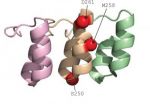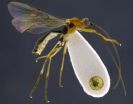(Press-News.org) WASHINGTON - Primary care teams that include both psychologists and physicians would help address known barriers to improved primary health care, including missed diagnoses, a lack of attention to behavioral factors and limited patient access to needed care, according to health care experts writing in a special issue of American Psychologist, the flagship journal of the American Psychological Association.
"At the heart of the new primary care team is a partnership between a primary care clinician and a psychologist or other mental health professional. The team works together to produce a comprehensive, integrated personal care plan for each patient that includes attention to mental and medical disorders, addresses substance abuse issues and incorporates health behavior change," wrote Susan H. McDaniel, PhD, of the University of Rochester Medical Center, and Frank V. deGruy III, MD, of the University of Colorado Denver School of Medicine, in An Introduction to Primary Care and Psychology.
The special issue has 11 articles, co-authored by psychologists and primary care physicians, covering areas including pediatrics, obstetrics and gynecology, palliative care, military service members' and veterans' health services, and care for special needs groups such as people with serious mental illness, refugees and deaf people.
"Improving our national health care system requires strengthening primary care, which covers a large majority of health care needs for individuals and families," said Norman B. Anderson, PhD, APA chief executive officer and American Psychologist editor. "Research clearly shows that psychological, behavioral and social factors are key drivers of health problems seen in the primary care settings. This special issue highlights some opportunities, challenges and successes in incorporating psychology into collaborative integrated health care to achieve truly comprehensive, whole-person primary care."
"The majority of people in the United States receive care for mental disorders, substance use disorders and health behavior problems in the primary care setting," wrote McDaniel and deGruy, who served as the issue's scholarly leads. "Yet primary care professionals have up to this point been poorly equipped to address these behavioral concerns adequately - they diagnose less than one-third of patients so afflicted and provide acceptable treatment for less than half of those correctly identified."
Articles include:
Proximity of Providers: Co-locating Behavioral Health and Primary Care and the Prospects for an Integrated Workforce
A 2009 survey of 6,600 primary care physicians found that two-thirds could not gain access to mental health services for their patients, often because of shortages of behavioral health care providers. "Even where these relationships exist, there have been systemic barriers to sustaining collaboration, such as health insurance obstacles and lack of health care coverage," wrote authors Benjamin F. Miller, PsyD, and Larry A. Green, MD, both of the University of Colorado Denver School of Medicine.
Contact: Benjamin Miller at Benjamin.miller@ucdenver.edu
Psychologists and Pediatricians: Opportunities for Collaboration in Primary Care
"Pediatric primary care settings provide the most accessible and least stigmatizing resource for many families who have concerns about their children's development and/or behavior," wrote co-authors Terry Stancin, PhD, of MetroHealth Medical Center, Cleveland, and Case Western Reserve University, and Ellen C. Perrin, MD, of the Floating Hospital for Children and Tufts Medical Center, Boston. Up to 66 percent of families referred for on-site counseling follow through with mental health referrals, compared with less than 5 percent of families referred for off-site counseling, research has found. Pediatric psychologists can address complex family issues and help foster skills to cope with treatment. Psychology interventions that have helped children suffering from asthma can be adapted for many other conditions, such as diabetes, seizures, cancer, sickle cell anemia, Crohn's disease and migraine headaches, according to the article.
Contact: Terry Stancin at tstancin@metrohealth.org
Psychologists Partnering with Obstetricians and Gynecologists: Meeting the Need for Patient-Centered Models of Women's Health Care Delivery
Co-authors Ellen L. Poleshuck, PhD, and James Woods, MD, both of the University of Rochester Medical Center, explain how common physical health issues among women, such as problems with menstruation, pregnancy and menopause, are closely linked with behavioral health. Women are nearly four times more likely to follow up with behavioral health treatment when services are offered at the same site, according to the research.
Contact: Ellen Poleshuck at Ellen_Poleshuck@urmc.rochester.edu
Applying the Inter-professional Patient Aligned Care Team in the Department of Veterans Affairs: Transforming Primary Care and Tipping Points in the Department of Defense's Experience with Psychologists in Primary Care
Lead authors Christopher L. Hunter, PhD, of the Defense Health Agency, and Lisa K. Kearney, PhD, of the Veterans Health Administration, Department of Veterans Affairs, and University of Texas, provide examples of successful collaborative integrated care programs for service members and veterans. The Department of Defense and Veterans' Affairs "have developed some of the most advanced integrated primary care solutions in existence, with the particular health care needs of soldiers and veterans in mind. Psychologists are deeply integrated into leadership position in their primary care systems," wrote McDaniel and DeGruy.
Contact: Christopher Hunter at Christopher.hunter@dha.mil or Lisa Kearney at LisaKearney3@va.gov
Other articles include:
Opportunities for Psychologists in Palliative Care: Working With Patients and Families Across the Disease Continuum, by Julia E. Kasl-Godley, PhD, VA Palo Alto Health Care System; Deborah A. King, PhD, of the University of Rochester Medical Center and VA Center of Excellence for Suicide Prevention; and Timothy E. Quill, MD, of the University of Rochester.
Contact: Julia Kasl-Godley at julia.kasl-godley@va.gov
Integrating Primary Care and Behavioral Health With Four Special Populations: Children With Special Needs, People With Serious Mental Illness, Refugees, and Deaf People, by Robert Q. Pollard Jr., PhD, Jennifer K. Carroll, MD, and Steven Barnett, MD, of the University of Rochester; Jeanette A. Waxmonsky, PhD, William R. Betts, PhD, Frank V. deGruy, MD, Laura L. Pickler, MD, and Yvonne Kellar-Guenther, PhD, of the University of Colorado Denver School of Medicine.
Contact: Robert Pollard Jr. at Robert_Pollard@urmc.rochester.edu
New Collaborations for Providing Effective Care for Adults With Chronic Health Conditions, by Lawrence Fisher, PhD, of the University of California, San Francisco, and Perry W. Dickinson, MD, of the University of Colorado Health Sciences Center.
Contact: Perry Dickinson at perry.dickinson@ucdenver.edu
Research and Evaluation in the Transformation of Primary Care, by C.J. Peek, PhD, University of Minnesota; Deborah J. Cohen, PhD, Oregon Health & Science University, and Frank V. deGruy III, MD, University of Colorado Denver School of Medicine.
Contact: C.J. Peek at cjpeek@umn.edu
Competencies for Psychology Practice in Primary Care, by Susan H. McDaniel, PhD, of the University of Rochester Medical Center; Catherine L Grus, PhD, APA Education Directorate; Barbara Cubic, PhD, Eastern Virginia Medical School; Christopher Hunter, PhD, Defense Health Agency; Lisa K. Kearney, PhD, of the Veterans Health Administration, Department of Veterans Affairs, and University of Texas; Catherine Schuman, PhD; Harvard Medical School; Michel J. Karel, PhD, Department of Veterans Affairs; Rodger S. Kessler, PhD, Vermont College of Medicine; Kevin Larkin, PhD, West Virginia University; Stephen McCutcheon, PhD, VA Puget Sound Health Care system; Benjamin F. Miller, PsyD, University of Colorado Denver School of Medicine; Justin Nash, PhD, Brown University and Memorial Hospital of Rhode Island; Sara Qualls, PhD, University of Colorado; Kathryn Sanders, PhD, VA Connecticut Healthcare System and Yale University School of Medicine; Terry Stancin, PhD, MetroHealth Medical Center, Cleveland, and Case Western Reserve University; Annette L. Stanton, PhD, University of California, Los Angeles; Lynne Sturm, PhD, Indiana University School of Medicine; Suzanne Bennett Johnson, PhD, Florida State University College of Medicine.
Contact: Susan H. McDaniel at susanh2_mcdaniel@urmc.rochester.edu
INFORMATION:
Copies of articles are available from APA Public Affairs, (202) 336-5700.
Special Issue: Primary Care and Psychology, American Psychologist, May 2014
Contact: Susan H. McDaniel at susanh2_mcdaniel@urmc.rochester.edu
The American Psychological Association, in Washington, D.C., is the largest scientific and professional organization representing psychology in the United States. APA's membership includes more than 134,000 researchers, educators, clinicians, consultants and students. Through its divisions in 54 subfields of psychology and affiliations with 60 state, territorial and Canadian provincial associations, APA works to advance the creation, communication and application of psychological knowledge to benefit society and improve people's lives.
http://www.apa.org
If you do not want to receive APA news releases, please let us know at public.affairs@apa.org or 202-336-5700.
Collaboration between psychologists and physicians important to improving primary health care
Such partnering would improve diagnosis and access; 2 known barriers to better primary care outcomes
2014-05-08
ELSE PRESS RELEASES FROM THIS DATE:
Small mutation changes brain freeze to hot foot
2014-05-08
DURHAM, N.C. -- Ice cream lovers and hot tea drinkers with sensitive teeth could one day have a reason to celebrate a new finding from Duke University researchers. The scientists have found a very small change in a single protein that turns a cold-sensitive receptor into one that senses heat.
Understanding sensation and pain at this level could lead to more specific pain relievers that wouldn't affect the central nervous system, likely producing less severe side effects than existing medications, said Jörg Grandl, Ph.D., an assistant professor of neurobiology in Duke's ...
Statins given early decrease progression of kidney disease
2014-05-08
AURORA, Colo. (May 8, 2014) - Results from a study by University of Colorado School of Medicine researchers show that pravastatin, a medicine widely used for treatment of high cholesterol, also slows down the growth of kidney cysts in children and young adults with autosomal dominant polycystic kidney disease (ADPKD).
ADPKD is the most common potentially lethal hereditary kidney disease, affecting at least 1 in 1000 people. ADPKD is characterized by progressive kidney enlargement due to cyst growth, which results in loss of kidney function over time. At one time, ADPKD ...
Mummy-making wasps discovered in Ecuador
2014-05-08
Some Ecuadorian tribes were famous for making mummified shrunken heads from the remains of their conquered foes. Field work in the cloud forests of Ecuador by Professor Scott Shaw, University of Wyoming, Laramie, and colleagues, has resulted in the discovery of 24 new species of Aleiodes wasps that mummify caterpillars. The research by Eduardo Shimbori, Universidade Federal de São Carlos, Brazil, and Scott Shaw, was recently published in the open access journal ZooKeys.
Among the 24 new insect species described by Shimbori and Shaw, several were named after famous people ...
NASA sees system 91B lingering over southwestern India
2014-05-08
The tropical low pressure area known as System 91B has been making a slow northerly crawl while sitting inland in southwestern India, and NASA's Terra satellite captured a visible image of the struggling storm that showed half of it is over the Northern Indian Ocean.
NASA's Terra satellite passed over System 91B over southwestern India and the Moderate Resolution Imaging Spectroradiometer (MODIS) instrument captured a visible image on May 8 at 05:40 UTC/1:40 a.m. EDT. The despite having a poorly defined low-level circulation center on infrared imagery, the circulation ...
Experimental antibody shows early promise for treatment of childhood tumor
2014-05-08
Tumors shrank or disappeared and disease progression was temporarily halted in 15 children with advanced neuroblastoma enrolled in a safety study of an experimental antibody produced at St. Jude Children's Research Hospital. Four patients are still alive after more than two-and-a-half years and without additional treatment.
Findings from the Phase I study were published recently online and will appear in the May 10 edition of the Journal of Clinical Oncology. The results prompted St. Jude to expand clinical trials of the monoclonal antibody hu14.18K322A to include patients ...
Wake Forest Baptist finds success with novel lung cancer treatment
2014-05-08
WINSTON-SALEM, N.C. – May 8, 2014 – An old idea of retreating lung tumors with radiation is new again, especially with the technological advances seen in radiation oncology over the last decade.
The Comprehensive Cancer Center of Wake Forest Baptist Medical Center is one of only a handful of cancer centers that is attempting to give lung cancer patients out of treatment options a chance to keep the cancer at bay. For these patients, hope lies in a second course of treatment – repeat radiation. Two complementary papers published back-to-back recently in the journal Radiotherapy ...
Health screening for low-income women under health care reform: Better or worse?
2014-05-08
New Rochelle, NY, May 8, 2014—When Massachusetts enacted its own statewide health insurance reform in 2006, low-income women transitioned from receiving free, federally subsidized screening for breast and cervical cancer and cardiovascular disease risk to an insurance-based payment system. The effects on screening rates in this vulnerable population are explored in Journal of Women's Health, a peer-reviewed publication from Mary Ann Liebert, Inc., publishers. The article is available free on the Journal of Women's Health website at http://online.liebertpub.com/doi/full/10.1089/jwh.2013.4612.
A ...
This FIB doesn't lie: New NIST microscope sees what others can't
2014-05-08
Microscopes don't exactly lie, but their limitations affect the truths they can tell. For example, scanning electron microscopes (SEMs) simply can't see materials that don't conduct electricity very well, and their high energies can actually damage some types of samples.
In an effort to extract a little more truth from the world of nanomaterials and nanostructures, researchers at the National Institute of Standards and Technology (NIST) have built the first low-energy focused ion beam (FIB) microscope that uses a lithium ion source.*
The team's new approach opens up ...
Oregon researchers capture handoff of tracked object between brain hemispheres
2014-05-08
EUGENE, Ore. -- When tracking a moving object, the two halves of the human brain operate much like runners successfully passing a baton during a relay race, says a University of Oregon researcher.
In a study online ahead of print in Current Biology, electroencephalogram (EEG) measured brainwaves from healthy young adults revealed how information about an attended object -- one being watched closely -- moves from one brain hemisphere to the other.
Such handoffs are necessary because the human visual system is contralateral; objects on the left side of space are processed ...
New grasshopper species named after Grammy winner
2014-05-08
A newly discovered grasshopper by University of Central Florida scientists now bears the name of Grammy-award winning singer and activist Ana Lila Downs Sanchez.
The scientists named the new species discovered on the side of a mountain road near Oaxaca, Mexico, after the Mexican-American singer as a nod to her efforts to preserve indigenous culture and penchant for wearing colorful, local costumes as part of her performances.
"It was primarily Paolo's idea to name the grasshopper after the singer" said Derek Woller, one of the authors of the paper referring to colleague ...
LAST 30 PRESS RELEASES:
Air pollution exposure and birth weight
Obstructive sleep apnea risk and mental health conditions among older adults
How talking slows eye movements behind the wheel
The Ceramic Society of Japan’s Oxoate Ceramics Research Association launches new international book project
Heart-brain connection: international study reveals the role of the vagus nerve in keeping the heart young
Researchers identify Rb1 as a predictive biomarker for a new therapeutic strategy in some breast cancers
Survey reveals ethical gaps slowing AI adoption in pediatric surgery
Stimulant ADHD medications work differently than thought
AI overestimates how smart people are, according to HSE economists
HSE researchers create genome-wide map of quadruplexes
Scientists boost cell "powerhouses" to burn more calories
Automatic label checking: The missing step in making reliable medical AI
Low daily alcohol intake linked to 50% heightened mouth cancer risk in India
American Meteorological Society announces Rick Spinrad as 2026 President-Elect
Biomass-based carbon capture spotlighted in newly released global climate webinar recording
Illuminating invisible nano pollutants: advanced bioimaging tracks the full journey of emerging nanoscale contaminants in living systems
How does age affect recovery from spinal cord injury?
Novel AI tool offers prognosis for patients with head and neck cancer
Fathers’ microplastic exposure tied to their children’s metabolic problems
Research validates laboratory model for studying high-grade serous ovarian cancer
SIR 2026 delivers transformative breakthroughs in minimally invasive medicine to improve patient care
Stem Cell Reports most downloaded papers of 2025 highlight the breadth and impact of stem cell research
Oxford-led study estimates NHS spends around 3% of its primary and secondary care budget on the health impacts of heat and cold in England
A researcher’s long quest leads to a smart composite breakthrough
Urban wild bees act as “microbial sensors” of city health.
New study finds where you live affects recovery after a hip fracture
Forecasting the impact of fully automated vehicle adoption on US road traffic injuries
Alcohol-related hospitalizations from 2016 to 2022
Semaglutide and hospitalizations in patients with obesity and established cardiovascular disease
Researchers ‘listen in’ to embryo-mother interactions during implantation using a culture system replicating the womb lining
[Press-News.org] Collaboration between psychologists and physicians important to improving primary health careSuch partnering would improve diagnosis and access; 2 known barriers to better primary care outcomes






